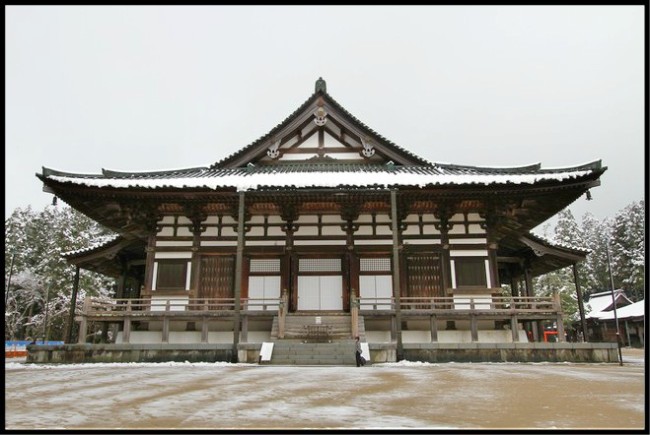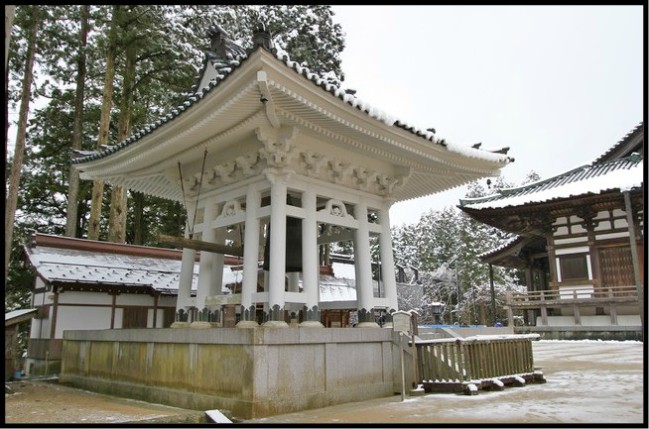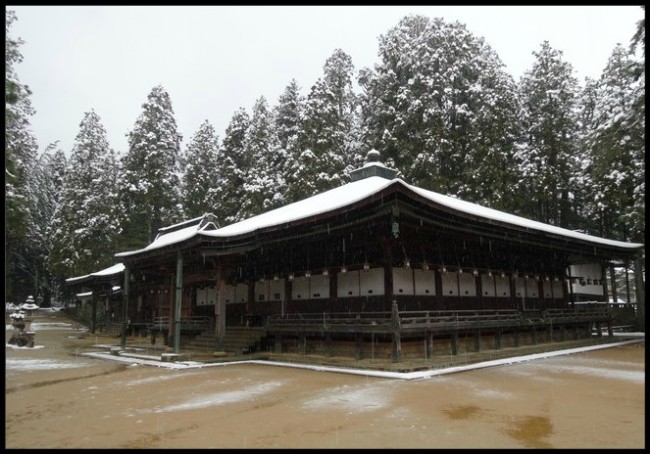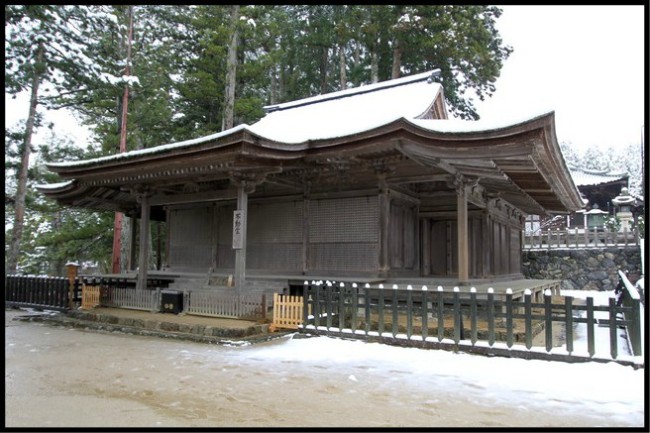
In this two part review (this being part 1) I will introduce you to some of the main buildings and structures within the Danjo Garan Complex – the headquarters of Shingon Buddhism in Japan. If you have not read my introductory review on the complex and how it came to be where it is I recommend you do so prior to continuing. I should point out that while the interiors of some (but not all) of the buildings are accessible time, on a single day trip from Osaka, did not permit me to indulge myself in an internal examination.
Konpon Daito Pagoda – Great Pagoda
The Konpon Daito Pagoda is without doubt the most noticeable and colourful of the twenty odd temples and buildings in the Danjo Garan.
The bright vermilion 48.5 metres high two-storied tahoto style pagoda stands in the centre of the Garan.
The building of the original pagoda was started by Kobo Daishi, the founder of Shingon Buddhism in Japan, in 816. It was completed by his successor Shinzen Daitoku in 887, 52 years after the passing of Kobo Daishi into his state of eternal meditation at Okunoin. The pagoda has been destroyed by fire and rebuilt six times since then, the most recent one being built in 1937 and renovated in 1996.
Right in the centre of the pagoda stands a statue of the Dainichi Nyorai (Cosmic Buddha, also known as Variocana), the central Buddha in Shingon Buddhism. Dainichi Nyorai is surrounded by four assisting Kongokai Buddhas and brightly coloured paintings of Bodhisattva on each of sixteen surrounding pillars. Together, these make up a very rare three dimensional mandala (a metaphysical map of the cosmos). Mandala are usually two dimensional paintings.
Pagoda opening hours
Daily from 8.30am and 5.00pm.
Entrance fee
Y200
Holders of the Koyasan-World Heritage Ticket – Y160
Holders of a Y2000 Combination Ticket – Free
Kondo Hall

When the priest Kukai arrived on Mt Koyo to establish Shingon Buddhism in Japan his most immediate need, in 819, was a temple and a meeting/lecture hall. Kondo Hall finished by his successor Shinzen Daitoku is the resultant meeting/lecture hall.
Like the pagoda, the wooden Kondo Hall has burned down numerous times over the years and the current hall was built in 1932.
Major services, ceremonies and other events are held in Kondo Hall.
The Hall enshrines an image of Yakushi Nyorai, the Buddha of medicine and healing. While the Kondo Hall is open to the public Yakushi Nyorai is not on display.
As I understand it, various mandalas, wall paintings and a large mural of of the Buddha’s enlightenment can be seen.
Opening hours and entrance fee: as per Konpon Daito Pagoda – detailed above.
Koyashiro – The Temple Bell

When Kobo Daishi set about building his temple, the Konpon Daito Pagoda, and the Kondo Hall, he determined that a bell was also required. Like the buildings, he did not live to see the bell installed. It too was installed by his successor, Shinzen Daitoku, in the later part of the 9th century.
The copper bell located close to the temple today was cast in 1549. Measuring 2.12 metres in diameter it is the fourth largest bell in Japan.
The bell is rung five times daily, at 4:00 am, 1:00 pm, 5:00 pm (during the spring equinox, at 6:00 pm), 9:00 pm, and at 11:00 pm.
Located in the Garan grounds, the bell can be viewed, free of charge, any time of the day or the night.
Miedo (Great Portrait Hall)

Originally Kobo Daishi’s personal training and meditation hall this building was later used to enshrine an image of Kobo Daishi, created by one of his disciples -Takaoka Shinno. At this point the building became the ‘Great Portrait Hall’. The Miedo is considered a most sacred location on Mount Koya with few permitted to enter though each year on 21st March lay visitors are allowed to enter and can see the painting set amidst ten other works of his disciples.
One 21 March 835 Kobo Daishi entered into eternal meditation in a cave in the nearby Okunoin Cemetery. Each year thousands of followers assemble and lay flowers and candles at his shrine before joining a procession to Danjo Garan and the Miedo, which is opened for the occasion. While a ticket is required to enter it is free and serves to show that the visitor has participated in the Kyusho Mieku festival commemorations.
Alas, I was not there on 21st March and had to make do with a sneak look in through one of the windows. The other picture above depicts some nice stone lanterns located close-by the Miedo.
Fudo-do (Acala Temple)

This, one of the least assuming buildings in the Danjo Garan temple complex, is the oldest extant building on the site though, like all the others, not an original. The original Fudo-do was built by Bishop Gyosho in 1197 in a nearby valley, having been commissioned by Hachijo Nyoin, daughter of Emperor Go-Toba and Imperial Princess.
The temple was rebuilt in its present form, as much resembling a Heian period house as a temple, in the early14th century and subsequently moved to the Garan. Each of the four corners of the temple is slightly different as each of the four craftsmen engaged in the construction added a little of themselves.
It is thought that the temple originally enshrined an image of Amhitaba (the Buddha of Immeasurable Life and Light) but later came to enshrine the highly venerated guardian deity, Acala (Fudo) and his eight attendants. Despite his frightening appearance, Acala is among the most trusted and beloved of Japanese Buddhist deities protecting followers by burning away impediments thus aiding them towards enlightenment.
I don’t think visitors are permitted inside this temple. It was certainly firmly locked up during my visit – with no peep-holes!
Address: 152 Koyasan, Koyasan
Do stay with me for Part 2 of this review wherein I will cover more buildings with the Danjo Garan temple complex.
For my next KOYASAN review (Part 2 of this review) click HERE.
To start reading at the beginning of my Koyasan reviews click HERE.

















They may be replicas for the most part but the buildings are nevertheless all stunning – especially the red of the Great Pagoda and the more delicately shaded Kondo Hall
LikeLiked by 1 person
Danjo Karan looks like an interesting place to visit for the architecture alone. Is it a very spiritual place as well?
LikeLiked by 1 person
It is indeed Malcolm, though given the awful weather we had even the monks were hidden away inside. We saw a few scurry between buildings. The complex is the headquarters of Shingon Buddhism though the cemetery and main temple are elsewhere in town.
LikeLike